On Friday Lynn Henning wrote a detailed look at Dontrelle Willis with a heavy emphasis on scouting. I found the article fascinating from the stand point of getting a better understanding of Willis’s repertoire as well as the thought processes that went along with approving the deal for the lefty. He was after all coming off a pretty rough year. I also viewed it as a chance to dust off that pitch f/x database I’ve had sitting dormant and explore whether or not the reports meshed with what the system had reported.
A little background
As a precursor, pitch f/x is a system deployed during the 2006 playoffs, and subsequently throughout MLB over the course of the 2007 season. It captures the velocity and trajectory of a pitch using several cameras and a lot of math. I wrote several articles using data from the system during the course of last season. Since the last time I delved into the data, there has been a ton of analysis done. Joe Sheehan, Dan Fox, John Walsh and others have cranked out some awesome stuff using this. But Mike Fast has really taken to the data and not only has bookmarked all the research to date, but has conducted a considerable amount on his own. I mention Fast so much because I borrowed heavily from his methods and I am very grateful.
The system wasn’t in place at all stadiums for the full season. The bulk of the data presented below was captured from seven starts, all of which came from July forward.
What does he throw?
From Henning:
His repertoire is as unique as his delivery. While his sinking, two-seam fastball is conventional, Willis throws a breaking ball that is not quite an overhand curve, and not a slider. It is closer to a “10-to-4” curveball than a classic, diving “12-to-6” breaking pitch.
His best weapon in the estimation of Wiley is Willis’ version of a change-up. It’s an off-speed fastball that cruises from 84-87 mph with tremendous sink.
Henning also notes that Willis’s 4 seamer tops out at 93 to 94.
Using a process called K-means clustering I went into Dontrelle’s pitch f/x data and grouped pitches by similarity of velocity and movement. The results are displayed graphically below:
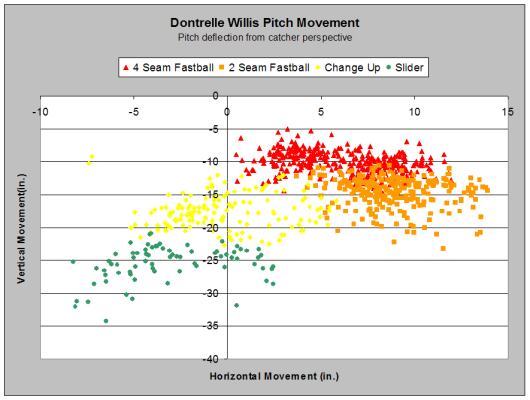
The graph is from the catcher’s perspective and represents the movement that a hitter would see on Willis’s pitches including gravity. So Willis’s curve-ish slider dives towards the feet of right handed batters.
The 2-seam fastball has a little more sink than the straighter 4-seamer with both tailing into the left handed batter. The change-up does appear to tumble as described, with more sink than the 2-seamer but less lateral movement.
A tabular view including the average velocity is below:
| Pitch | N | Mean Velocity |
| 2 Seam Fastball | 259 | 86.8 |
| 4 Seam Fastball | 357 | 91.1 |
| Change Up | 146 | 83.7 |
| Slider | 73 | 78.0 |
This seems to reason check as well. An average heater in the low 90’s with the sinker a couple ticks slower. The change-up is on the lower end of what the scout explained, but that could be my issue. The number of breaking pitches seems pretty low, and the difference between the change and slider is pretty small mathematically. There’s a decent chance that I’ve misclassified some of the sliders as change-ups, dropping the overall velocity of the pitch.
Where does he throw it?
Dontrelle had problems with location last year.
He must be able to spot his four-seam fastball, which tops out at 93-94 mph. In particular, he must be able to throw it high and tight to right-handed hitters.
When Willis misses — and he missed a lot last year when that same fastball swung back across the plate — the ball can end up on a ride into the seats.
“His location was not nearly as good last year,” Russell said. “He was a little off as far as being able to pitch inside (to right-handed hitters). Last year, he was more middle-out, much more than he had normally been.
We can also take a look at where Willis was throwing to last year, and how that differentiated for left and right handed batters. Below is the graph for the 4-seam fastball. The pane on the left is for left handed hitters, and the pane on the right is right handed hitters. The center box in each pane is an approximation of the strike zone.
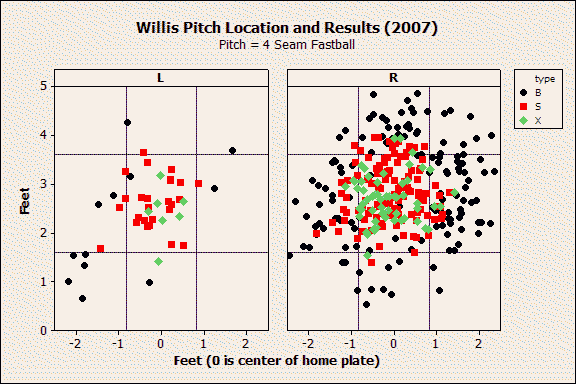
There certainly doesn’t appear to be a trend of jamming the right handed hitters with the 4 seamer, and when it was on the inner half of the plate it was put in play -with considerable success. Right handed batters against the 4-seam fastball hit .404 when putting the ball in play. Below is a table with the outcomes of each pitch to right handers.
Right Handed Batters
| Pitch | Ball | Call Str | Foul | Hit | Out | Sw Str | Swing % | Contact% | Total |
| 2 Seam Fastball | 98 | 50 | 25 | 17 | 35 | 7 | 36% | 92% | 232 |
| 4 Seam Fastball | 136 | 38 | 59 | 23 | 34 | 22 | 44% | 84% | 312 |
| Change Up | 52 | 7 | 33 | 9 | 11 | 15 | 54% | 78% | 127 |
| Slider | 32 | 6 | 13 | 3 | 8 | 6 | 44% | 80% | 68 |
| Total | 318 | 101 | 130 | 52 | 88 | 50 | 43% | 84% | 739 |
And now for the left handers, of which there weren’t many that faced Dontrelle.
Left Handed Batters
| Pitch | Ball | Call Str | Foul | Hit | Out | Sw Str | Swing % | Contact% | Total |
| 2 Seam Fastball | 11 | 7 | 6 | 2 | 1 | 33% | 89% | 27 | |
| 4 Seam Fastball | 12 | 6 | 14 | 2 | 5 | 6 | 0.6 | 78% | 45 |
| Change Up | 10 | 1 | 1 | 4 | 3 | 42% | 63% | 19 | |
| Slider | 1 | 1 | 1 | 2 | 0.6 | 33% | 5 | ||
| Total | 34 | 15 | 22 | 2 | 11 | 12 | 49% | 75% | 96 |
For the sake of completeness, here are the pitch location graphs for Willis’s other 3 pitches as well.
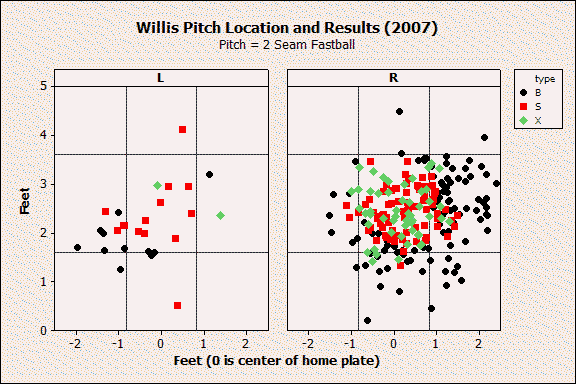
Willis keeps the 2-seamer away from both lefties and righties.
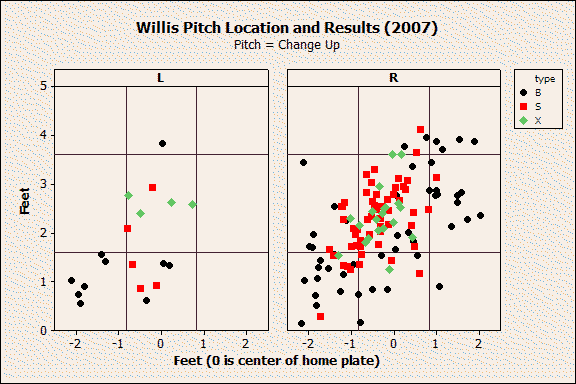
But he comes inside with the change-up to right handers. Again, some of those maybe sliders. And speaking of the slider, Willis doesn’t throw it in the strike zone a whole lot, but he manages to get a decent number of strikes via swings and misses
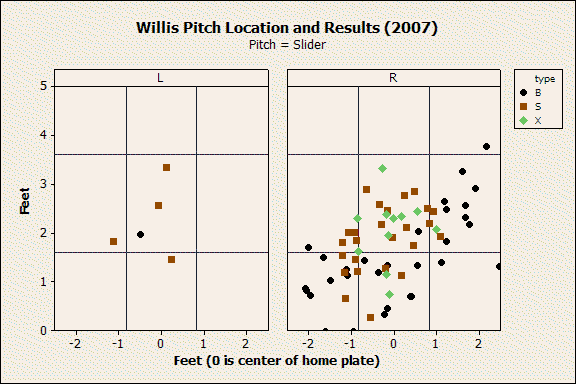
Staying ahead
By missing spots, the thought was that Willis was pitching from behind and having to go more fastball heavy.
He pitched behind in the count too many times and got into fastball counts.
Turning our attention to pitch count we see that Willis was throwing more pitches behind in the count than in a pitchers count.
| Count | 2 seam fastball | 4 seam fastball | Change Up | Slider | Total |
| 0-0 | 93 | 97 | 18 | 11 | 219 |
| 0-1 | 20 | 46 | 15 | 8 | 89 |
| 0-2 | 4 | 16 | 12 | 5 | 37 |
| 1-0 | 44 | 44 | 10 | 6 | 104 |
| 1-1 | 20 | 40 | 19 | 8 | 87 |
| 1-2 | 5 | 28 | 22 | 8 | 63 |
| 2-0 | 19 | 13 | 3 | 2 | 37 |
| 2-1 | 22 | 13 | 8 | 5 | 48 |
| 2-2 | 7 | 29 | 25 | 11 | 72 |
| 3-0 | 4 | 6 | 2 | 12 | |
| 3-1 | 8 | 4 | 1 | 13 | |
| 3-2 | 13 | 21 | 11 | 9 | 54 |
| Ahead | 29 | 90 | 49 | 21 | 189 |
| Behind | 110 | 101 | 35 | 22 | 268 |
| Even | 120 | 166 | 62 | 30 | 378 |
| All | 259 | 357 | 146 | 73 | 835 |
And graphically…
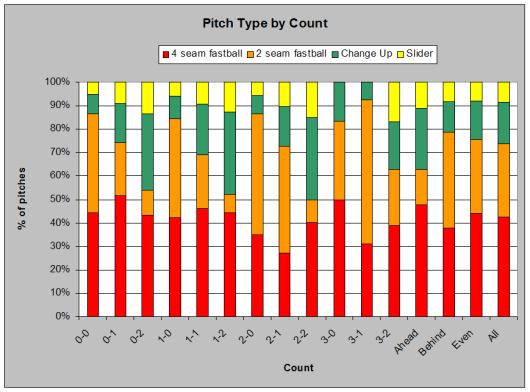
When behind in the count, Willis goes to one of his fastballs nearly 80% of the time. It keeps him from throwing the breaking pitch, which is quite effective but hard to control. In fact he only seems to go to the pitch with any consistency when he has two strikes. Also worth noting is the reliance on the fastball to start off an at-bat as well. The 85% fastball rate on first pitches is only surpassed when the count is 3-1.
As for whether pitching behind is new for Willis, it is. At least to a certain extent. In 2004 and 2005 Willis was staying ahead of the hitters. In 2006 it tipped the other way and last year was the widest gap.
Pitches thrown when Ahead/Even/Behind in the Count
| Year | Ahead | Behind | Even |
| 2003 | 26.0% | 30.9% | 43.1% |
| 2004 | 31.5% | 23.7% | 44.8% |
| 2005 | 29.8% | 25.2% | 45.0% |
| 2006 | 25.1% | 29.8% | 45.1% |
| 2007 | 23.8% | 32.1% | 44.2% |
Conclusions
Everything works out. The scouts validate the data and the data validates the scout – or at least the two are reasonable consistent. Any issues at the end of the year didn’t appear to be velocity related – at least as far the pitch f/x data reveals. This is consistent with the scouting reports. The issues seem to be centered squarely on control. I don’t know that his pitches were any more hittable than in past years, just that he ended up in less desirable situations because he wasn’t able to locate like he had in the past.
Whether this was due to a change in mechanics, a subconscious reaction to a poor defense, or the result of some arm pain remains to be seen. The challenge for Chuck Hernandez and Willis is to regain that control. It will be interesting to see how quickly Hernandez can get comfortable diagnosing and working with Dontrelle’s unorthodox delivery. Or perhaps there will be something to the change of scenery and playing in front of a full house. Still, given the 3 years the Tigers committed to Willis I have to believe they have a handle on the situation and are confident it can be corrected.
Holy crap! Spring training opens in a week and our bullpen still blows. We got to trade Maybin for a closer and a set-up guy!
Man, this is really good stuff Billfer. Tying the article in with the data (and the visual aids) was brilliant.
I’ll have to “amen” Matt in Toledo’s comments. Brilliant!
How about Maybin for Riske and Dotel from KC?!?
How about Maybin, Miller, and some others for Willis and Cabrera? I’ll jump in my time machine and get it done!
You wish Rick G, that would never happen!
that pitch f/x stuff is great
Psh, Rick, you know damn well that Maybin and Miller are untouchable.
i think he’ll be just fine.. they’ll get him worked out… he played on a worthless team last year…